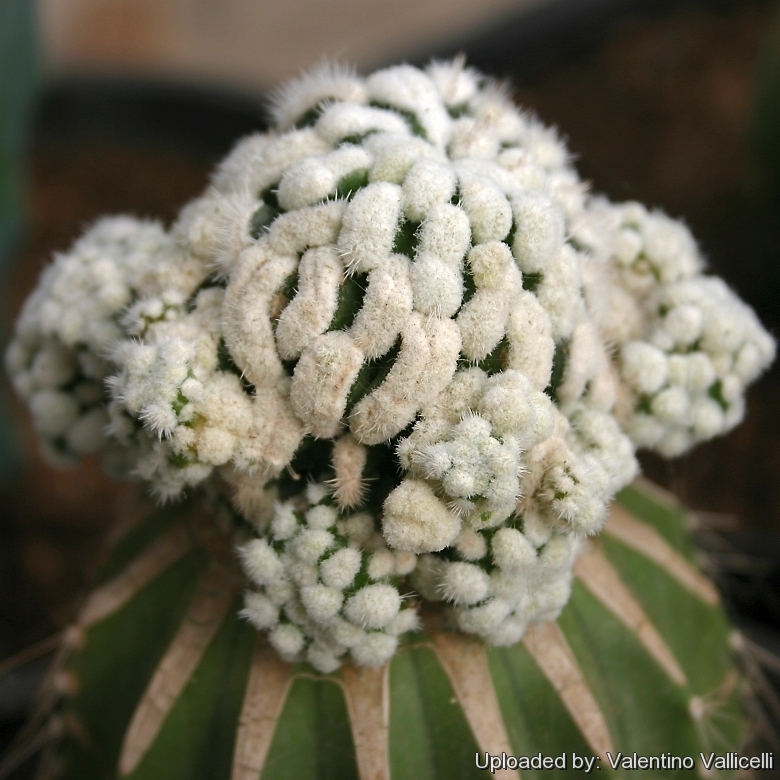Accepted Scientific Name: Mammillaria cv. Chiara Blando I.Blando
Cactus & Co. Vol. IX, 2, 115, 2005

Mammillaria cv. Blando Chiara (Mammillaria cv. Chiara Blando) Photo by: Valentino Vallicelli
Origin and Habitat: Garden origin (Nursery produced cultivar)
Synonyms:
Description: Mammillaria cv. Chiara BlandoSN|20723]]SN|16505]] (or " Blando Chiara ") is one of the most beautiful cultivars obtained by the cactus grower Ignazio Blando (Trapani, Sicily, Italy). This cultivar is an odd monstrous plant with narrow spineless areoles derived from the even more rare Mammillaria cv. Blando that was found in a batch of Mammillaria gueldelmanniana guirocobensis, obtained from seeds purchased from Khores (Germany).
Habit: This cultivars is easily grown into crowded clumps or mounds, but it does often have an irregular pattern of offsetting. Most plants will offset readily, and clumps can be produced in a few years.
Stem: Depressed-globose to somewhat elongated (depending on growing condition) 3-7 cm in diameter, green, with white wool in the centre, and also in the older areoles.
Tubercles: Hatchet-shaped, laterally compressed, and often thinner the the above standing areoles.
Areoles: Very distinctive, conspicuous, in relief, extremely elongated, 7-20 mm long and 3-5 mm broad, densely covered with dull white felt.
Spines: Absent, or few, very thin, bristly, white, less than 5 mm long scattered along the areole.
Flowers. Not seen.
Similar cultivars: A similar abnormal uncoordinated form of vegetative growth, is also seen in Mammillaria pectinifera f. monstruosaSN|16505]]SN|20723]].
Subspecies, varieties, forms and cultivars of plants belonging to the Mammillaria cultivars group
 Mammillaria cv. Blando I.Blando: Has very odd pectinated spines, that varies in number and density depending on clones.
Mammillaria cv. Blando I.Blando: Has very odd pectinated spines, that varies in number and density depending on clones. Mammillaria cv. Caterpincy: has very reduced bristly or absent spines. It offsets from the base to form a small cluster or mound. It is very similar to: Mammillaria crinita subs. painteri f. monstruosa (if not the same)
Mammillaria cv. Caterpincy: has very reduced bristly or absent spines. It offsets from the base to form a small cluster or mound. It is very similar to: Mammillaria crinita subs. painteri f. monstruosa (if not the same) Mammillaria cv. Cettina: It shows an abnormal uncoordinated form of vegetative growth, with a multitude of condensed lateral proliferation and plant looks more like a strange furry animal than a cactus.
Mammillaria cv. Cettina: It shows an abnormal uncoordinated form of vegetative growth, with a multitude of condensed lateral proliferation and plant looks more like a strange furry animal than a cactus. Mammillaria cv. Chiara Blando I.Blando: has extremely elongated areoles, 7-20 mm long and 3-5 mm broad, which are conspicuous, in relief, densely covered with dull white felt and few tiny white bristles.
Mammillaria cv. Chiara Blando I.Blando: has extremely elongated areoles, 7-20 mm long and 3-5 mm broad, which are conspicuous, in relief, densely covered with dull white felt and few tiny white bristles. Mammillaria hybrid cv. Dolichothele x Un Pico: a supposed hybrid between a Dolichothele longimamma and Mammillaria spinosissima cv. Un Pico. It has orange and yellow central spines that are a thin, little flat, flexible but not hooked.
Mammillaria hybrid cv. Dolichothele x Un Pico: a supposed hybrid between a Dolichothele longimamma and Mammillaria spinosissima cv. Un Pico. It has orange and yellow central spines that are a thin, little flat, flexible but not hooked. Mammillaria hybrid cv. Toumeya x knippelianus: it is an improbable hybrid between a Toumeya papyracantha and Echinocereus knippelianus or more likely a monstrous form of Mammillaria. Central spines orange, flexible, flat with a bent tip.Radial spines glassy white, bristly.
Mammillaria hybrid cv. Toumeya x knippelianus: it is an improbable hybrid between a Toumeya papyracantha and Echinocereus knippelianus or more likely a monstrous form of Mammillaria. Central spines orange, flexible, flat with a bent tip.Radial spines glassy white, bristly.
Bibliography: Major references and further lectures
1) Cactus & Co Vol. II, 2, 1998
2) Cactus & Co Vol. IX, 2, 115, 2005
Cultivation and Propagation: This plant is grown exclusively grafted. Keep well ventilated, protect from frosts and freezes. Give plenty of light to keep plant compact, but avoid direct sun exposure in the hottest part of the day during the summer.










